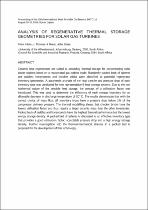JavaScript is disabled for your browser. Some features of this site may not work without it.
- ResearchSpace
- →
- Research Publications/Outputs
- →
- Conference Publications
- →
- View Item
| dc.contributor.author |
Klein, Peter

|
|
| dc.contributor.author |
Roos, TH

|
|
| dc.contributor.author |
Sheer, J

|
|
| dc.date.accessioned | 2015-03-12T10:20:52Z | |
| dc.date.available | 2015-03-12T10:20:52Z | |
| dc.date.issued | 2014-08 | |
| dc.identifier.citation | Klein, P, Roos, T.H and Sheer, J. 2014. Analysis of regenerative thermal storage geometries for solar gas turbines. In: Proceedings of the 15th International Heat Transfer Conference, IHTC-15, Kyoto, Japan, 10-15 August 2014 | en_US |
| dc.identifier.uri | http://dl.begellhouse.com/references/ihtc15,4b669bfd23c4bc5f,3090c2794b99601a.html | |
| dc.identifier.uri | http://hdl.handle.net/10204/7948 | |
| dc.description | Due to copyright restrictions, the attached PDF file only contains the abstract of the full text item. For access to the full text item, please consult the publisher's website. | en_US |
| dc.description.abstract | Ceramic heat regenerators are suited to providing thermal storage for concentrating solar power stations based on a recuperated gas turbine cycle. Randomly packed beds of spheres and saddles; honeycombs and checker bricks were identified as potential regenerator inventory geometries. A parametric analysis of the heat transfer and pressure drop of each inventory type was conducted for two representative 6 hour storage systems. Due to the non isothermal nature of the sensible heat storage, the concept of a utilisation factor was introduced. This was used to determine the efficiency of each storage inventory for an allowable decrease in discharge temperature of 50 oC. The results demonstrate that with the correct choice of mass flux, all inventory types have a pressure drop below 1% of the compressor delivery pressure. The thermal modelling shows that checker bricks have the lowest utilisation factor and thus require a larger ceramic mass than the other inventories. Packed beds of saddles and honeycombs have the highest thermal performance but the lowest energy storage density. A packed bed of spheres is discussed as an effective inventory type that provides a good utilisation factor, acceptable pressure drop and a high energy storage density. Further investigation into the thermal-mechanical stresses in a packed bed is proposed for the development of this technology. | en_US |
| dc.language.iso | en | en_US |
| dc.publisher | IHTC | en_US |
| dc.relation.ispartofseries | Workflow;14047 | |
| dc.subject | Concentrating solar power | en_US |
| dc.subject | CSP | en_US |
| dc.subject | Ceramic heat regenerator | en_US |
| dc.subject | Heat transfer | en_US |
| dc.subject | Solar gas turbines | en_US |
| dc.subject | Thermal storage geometries | en_US |
| dc.title | Analysis of regenerative thermal storage geometries for solar gas turbines | en_US |
| dc.type | Conference Presentation | en_US |
| dc.identifier.apacitation | Klein, P., Roos, T., & Sheer, J. (2014). Analysis of regenerative thermal storage geometries for solar gas turbines. IHTC. http://hdl.handle.net/10204/7948 | en_ZA |
| dc.identifier.chicagocitation | Klein, Peter, TH Roos, and J Sheer. "Analysis of regenerative thermal storage geometries for solar gas turbines." (2014): http://hdl.handle.net/10204/7948 | en_ZA |
| dc.identifier.vancouvercitation | Klein P, Roos T, Sheer J, Analysis of regenerative thermal storage geometries for solar gas turbines; IHTC; 2014. http://hdl.handle.net/10204/7948 . | en_ZA |
| dc.identifier.ris | TY - Conference Presentation AU - Klein, Peter AU - Roos, TH AU - Sheer, J AB - Ceramic heat regenerators are suited to providing thermal storage for concentrating solar power stations based on a recuperated gas turbine cycle. Randomly packed beds of spheres and saddles; honeycombs and checker bricks were identified as potential regenerator inventory geometries. A parametric analysis of the heat transfer and pressure drop of each inventory type was conducted for two representative 6 hour storage systems. Due to the non isothermal nature of the sensible heat storage, the concept of a utilisation factor was introduced. This was used to determine the efficiency of each storage inventory for an allowable decrease in discharge temperature of 50 oC. The results demonstrate that with the correct choice of mass flux, all inventory types have a pressure drop below 1% of the compressor delivery pressure. The thermal modelling shows that checker bricks have the lowest utilisation factor and thus require a larger ceramic mass than the other inventories. Packed beds of saddles and honeycombs have the highest thermal performance but the lowest energy storage density. A packed bed of spheres is discussed as an effective inventory type that provides a good utilisation factor, acceptable pressure drop and a high energy storage density. Further investigation into the thermal-mechanical stresses in a packed bed is proposed for the development of this technology. DA - 2014-08 DB - ResearchSpace DP - CSIR KW - Concentrating solar power KW - CSP KW - Ceramic heat regenerator KW - Heat transfer KW - Solar gas turbines KW - Thermal storage geometries LK - https://researchspace.csir.co.za PY - 2014 T1 - Analysis of regenerative thermal storage geometries for solar gas turbines TI - Analysis of regenerative thermal storage geometries for solar gas turbines UR - http://hdl.handle.net/10204/7948 ER - | en_ZA |






